Greetings, anatomy students! One might reasonably assume this lesson is about Billy Ray Cyrus, but, one would be wrong. This anatomy lesson discusses the very important, brachial artery, and its parent, the axillary artery!
And, what spurs a lesson about these vessels? Why, twisted-sista, Laoghaire, is to blame (Starz Outlander episode 308, First Wife)!
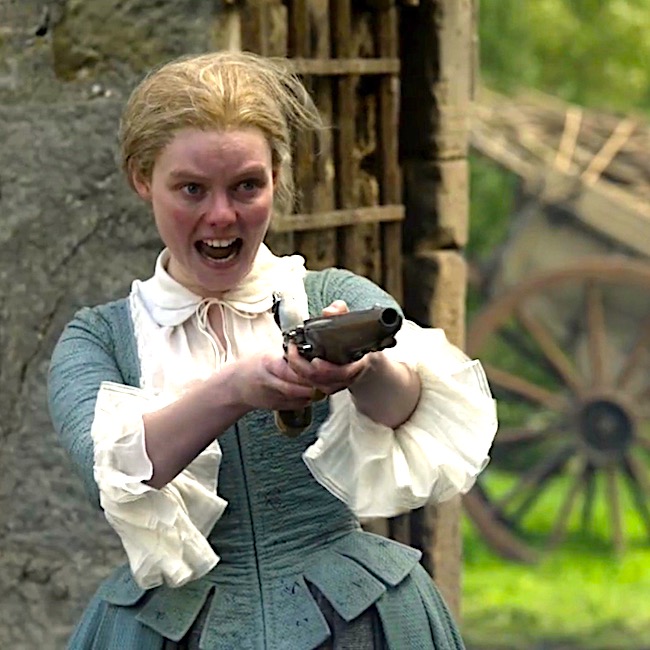
Who is in her sights – Jamie? Claire? Or, will she fell both with a single shot?
Blamo! A fouling piece discharges a fowling piece!
Dear Laoghaire:
On the day that you were born,
The angels got together……
And, were severely reprimanded!
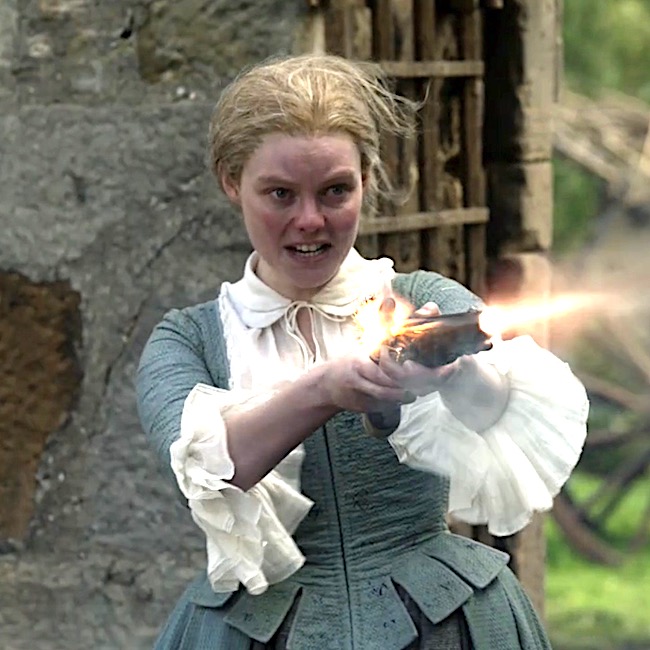
Shoot <g>! Laoghaire peppers Jamie with birdshot! Alas-lass, Granny Fitz probably wouldn’t be proud of her progeny.
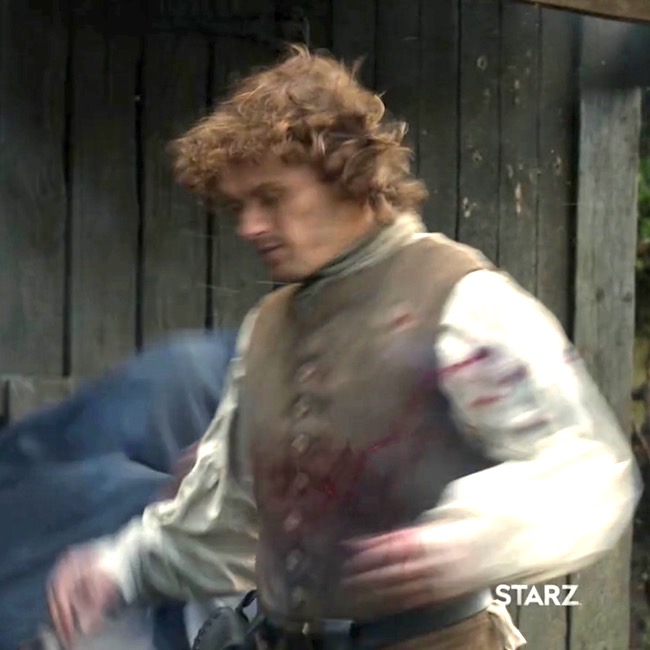
Laoghaire, Laoghaire, quite contrary,
How does your vengeance grow?
Jamie fell, amid bloody hell,
And, Claire became your foe!
Dinna mess with the Sassenach. Drop that weapon!
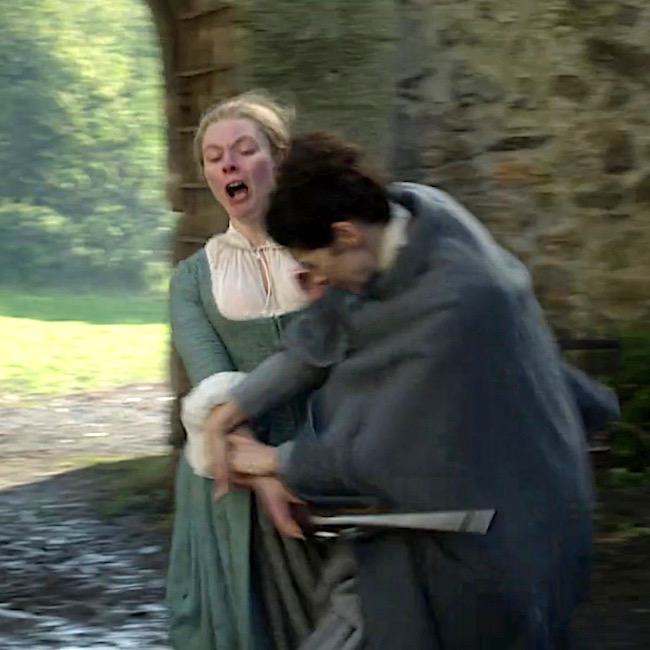
Now, book readers ken that things didn’t go down quite this way in Voyager book. Herself envisioned Claire fleeing Lallybroch upon finding that Jamie has a harem. Young Ian (bless his wee Scottish heart), catches up to her in the mountains and says:
“But Auntie Claire, it’s not that!”
“What’s not that?” Caught by his tone of desperation, I glanced up. His long, narrow face was tight with the anguished need to make me understand.
“Uncle Jamie didna stay to tend Laoghaire!”
“Then why did he send you?” He took a deep breath, renewing his grip on my reins.
“She shot him. He sent me to find ye, because he’s dying.”
Back to the TV version. Perhaps aiming for his heart, Laoghaire’s birdshot turns Jamie’s left chest, shoulder and arm into mincemeat. But, harboring absolute faith in his beloved he assures us:
“It’s only birdshot, nothing serious…..It’s nothing Claire canna fix!”
Back to Voyager book, Claire assesses Laoghaire’s assault:
“Let’s have a look at it.”
The wound itself was a ragged dark hole, scabbed at the edges and faintly blue-tinged. I pressed the flesh on either side of the wound; it was red and angry-looking, and there was a considerable seepage of pus. Jamie stirred uneasily as I drew my fingertips gently but firmly down the length of the muscle. “You have the makings of a very fine little infection there, my lad,” I said. “Young Ian said it went into your side; a second shot, or did it go through your arm?”
“It went through. Jenny dug the ball out of my side. That wasna so bad, though. Just an inch or so in.”
A bit of difference between the two versions but either way, Jamie needs his Claire! BTW, the special effects are terrific!
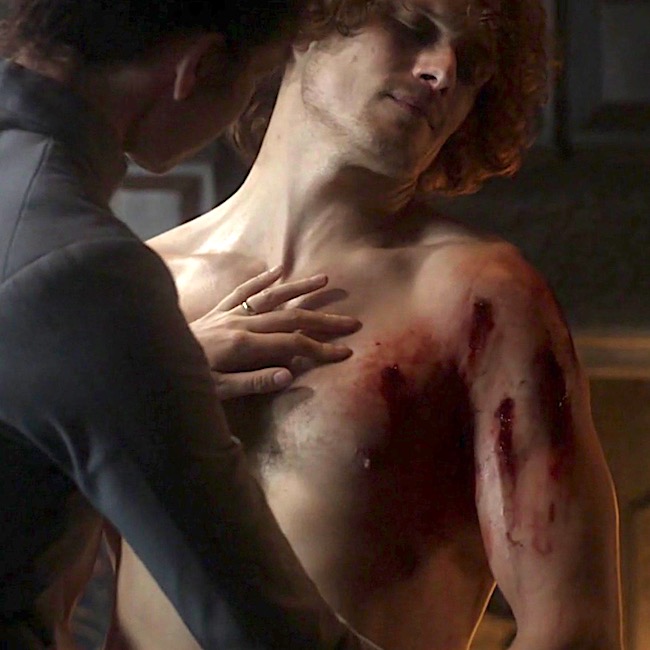
Back to TV: No surprise – Claire must remove those pesky pellets! Following the surgeon’s creed: a chance to cut, is a chance to cure, Claire sets to work!
Several big swigs of Scotch whisky and Jamie lolls unconscious… that stuff is potent! Armed with tools from her medical kit, Claire dives for those wee bits of lead!
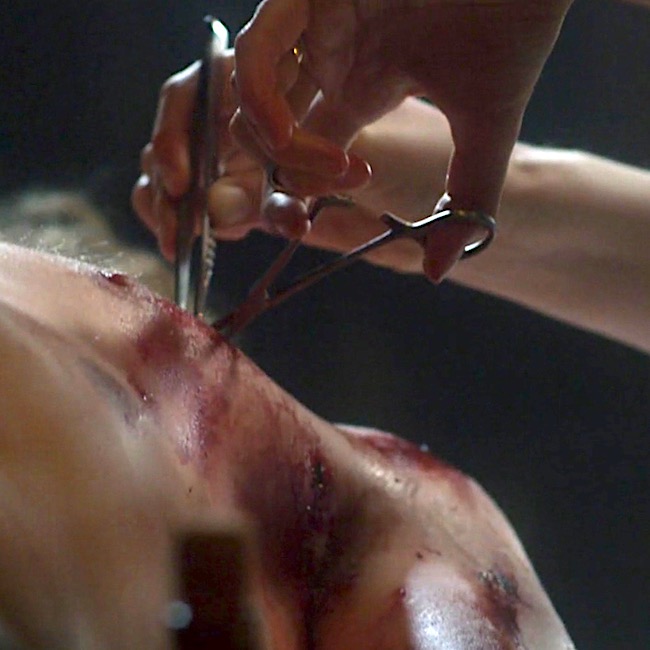
One by one, she carefully retrieves the pellets.
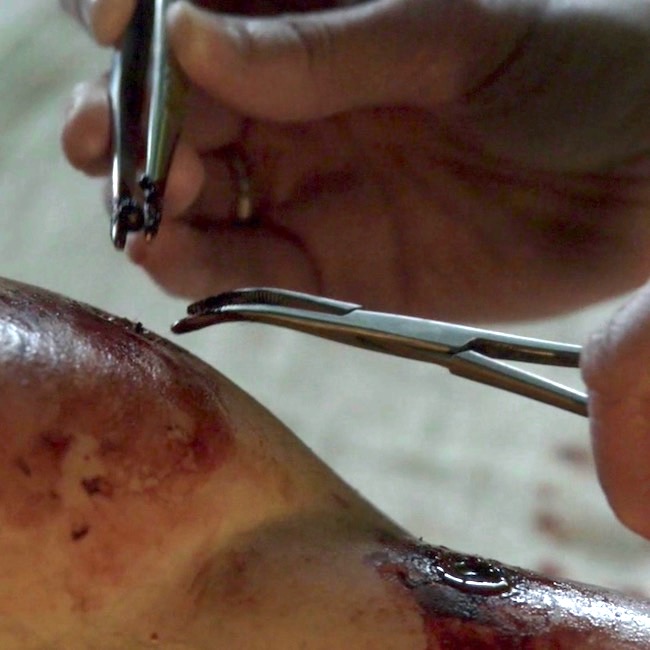
Mostly, the bird shot is superficial but one sits in a precarious position. She cut downs to reach the deep-lying pellet explaining to young Ian, she must avoid damaging the artery! Jamie could bleed to death if the vessel is injured by pellet or nicked by blade.
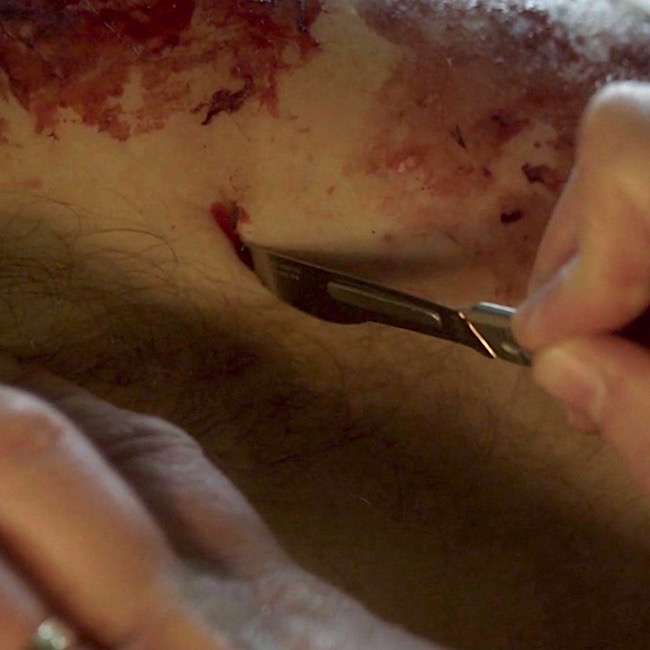
The next image exhibits a high yuk factor for some students, but Clair dutifully digs, dives and delves for the perilous pellet!
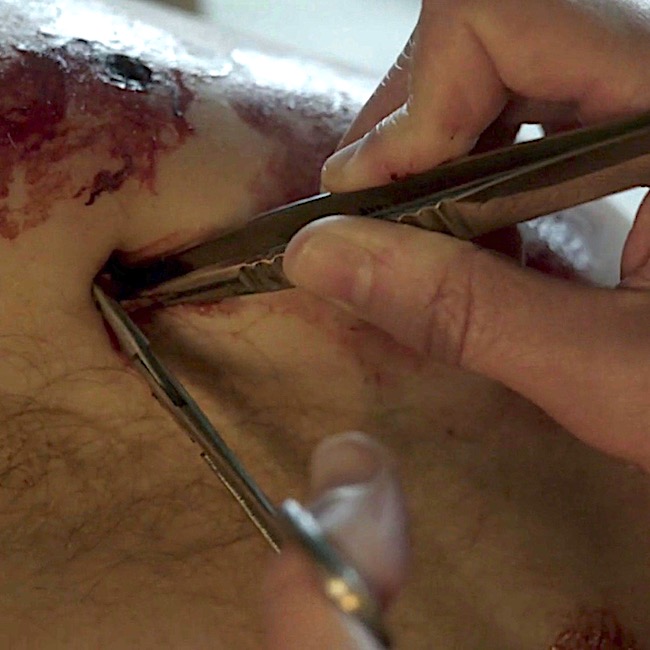
Into the brass vessel it goes – joining its brothers in crime.

Still royally pissed at Jamie’s deceit, Claire carefully stitches the incision (Anatomy Lesson #35, Outlander Owies!) and our Highland Hero is saved. This lass takes pride in her work!
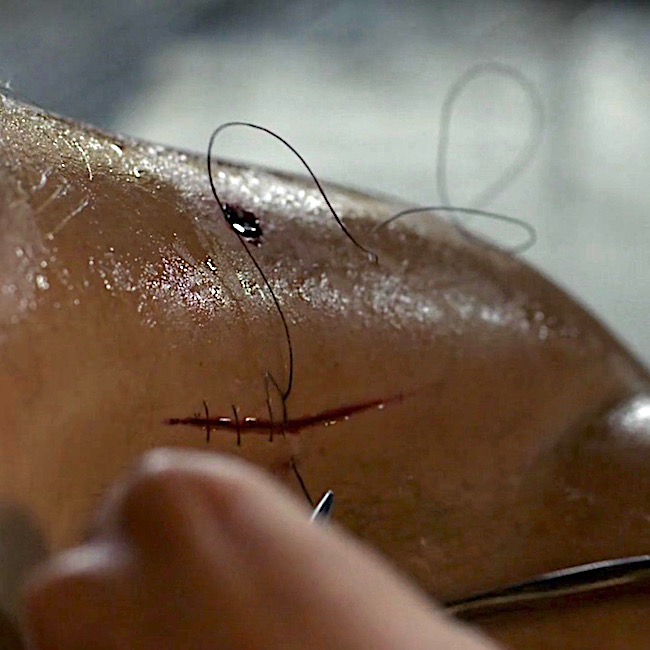
Anatomy Lesson: Sigh… time to leave Outlander and get to our lesson! Now, which artery does Claire believe is at risk? Let’s tease out the answer.
Judging from the location of the incision, we may reasonably surmise that Claire’s Concern is directed toward one of these two arteries:
- Axillary artery
- Achy brachial artery
Origins: To properly understand how these two arteries might be at risk from bird shot or scalpel blade, let’s study their ancestry.com. We begin at the heart. Image A is a highly simplified view of the heart (pink) and its major arteries (red and blue).
Aorta: The ascending aorta, the large red vessel, arises from the heart (left ventricle) and curves, becoming the arch of aorta. The arch is then renamed the descending aorta as it dives downward through chest and abdomen.
Anatomic Note #1: Traditionally, arteries appear red to denote they carry oxygenated blood. However, some arteries carry de-oxygenated blood such as the two blue vessels shown in Image A; these are right and left pulmonary arteries (from right ventricle). Their blood becomes oxygenated as it travels through the lungs. Not critical to today’s lesson, so more about these vessels in a later session!
Aortic Branches: Typically, the aortic arch gives rise to three large arteries. In 75% of people, aortic branches follow the pattern shown in Image A. But in 25% of folks, a different branching pattern ensues. My experience in the dissection lab is that blood vessels show the greatest variation of any anatomical structure. None-the-less, the typical branching pattern is:
- Brachiocephalic artery (dividing into)
- Right common carotid artery
- Right subclavian artery
- Left common carotid artery
- Left subclavian artery
Anatomic Note #2: The left side (on your right) typically lacks a brachiocephalic artery, so left common carotid and subclavian arteries branch directly off the aorta. On the right, the short brachiocephalic artery soon branches into right common carotid and subclavian arteries. Embryonic development produces this odd asymmetry.
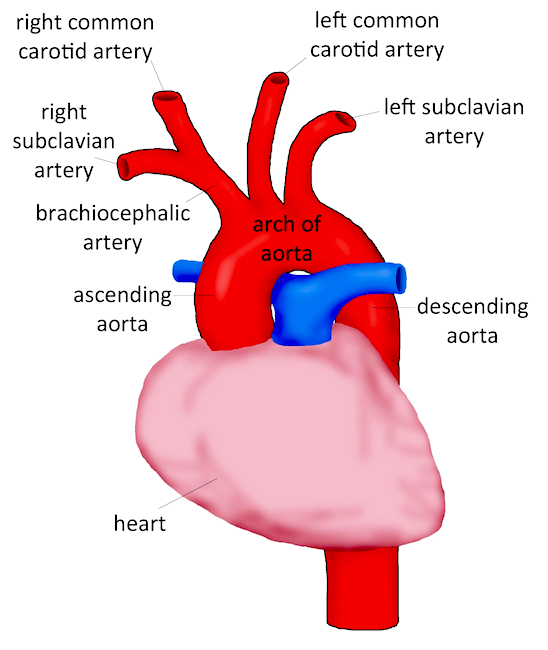
Destination: Once the brachiocephalic artery divides, its branches follow the same pattern as the left side (Image B):
- Right and left common carotid arteries ascend to supply head and neck
- Right and left subclavian arteries arch through base of neck.
- Name change #1: At outer border of the 1st ribs, subclavian arteries are renamed right and left axillary arteries.
- Name change #2: At lower border of teres major muscle (Anatomy Lesson #10, Jamie’s Back or Aye, Jamie’s Back!), axillary arteries are renamed right and left brachial arteries.
Gasp! Pray tell, who thought so many name changes would prove helpful? Early anatomists are to blame, waaay back in 1578!
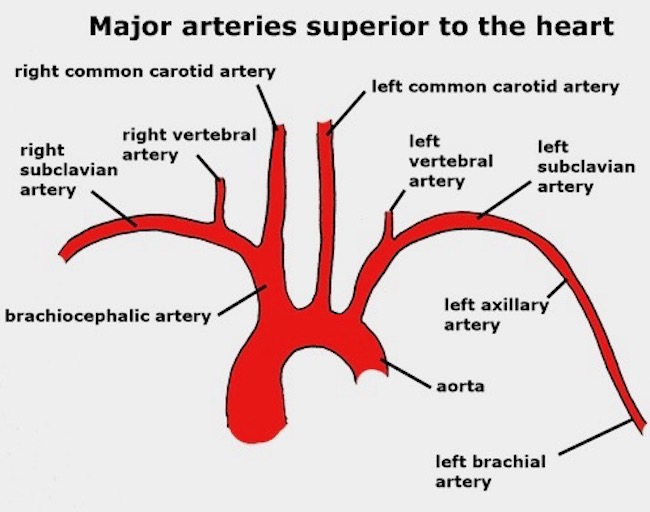
Image B
Axillary Artery: Subclavian arteries give off branches and then, like many city streets, each changes its name to axillary artery.
The word, axillary, comes from the Latin axillaris meaning “armpit,” because the axillary artery lies deep in the armpit, skirting outer ribs and angling through the oxter toward the arm (image C). Its important branches supply blood to:
- upper thorax (Anatomy Lesson #4, Jamie’s Chest – 8th Wonder of the World!)
- breast (Anatomy Lesson #51, The Breast – Male and Female)
- armpit
- scapula (shoulder blade)
Situated so deep in the armpit, axillary artery is protected and rather difficult to reach except by needle, open dissection, or bird shot!
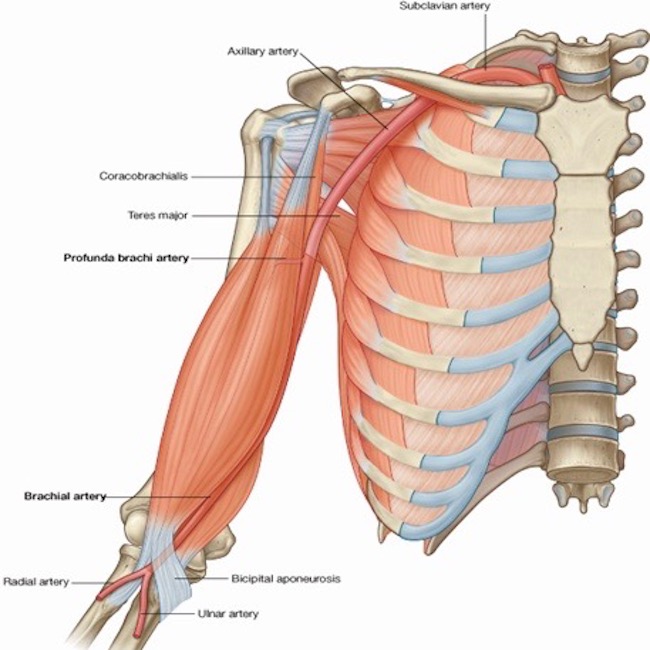
Image C
Brachial Artery: At the lower border of teres major muscle, each axillary artery is renamed the brachial artery, the major artery supplying each arm (Image D). Brachial comes from the Latin brac(c)hium meaning “arm.” The brachial artery continues into the arm supplying blood to its structures; then, ends near the elbow by dividing into radial and ulnar arteries (Anatomy Lesson #19, To Arms, Too Arms, Two Arms!).
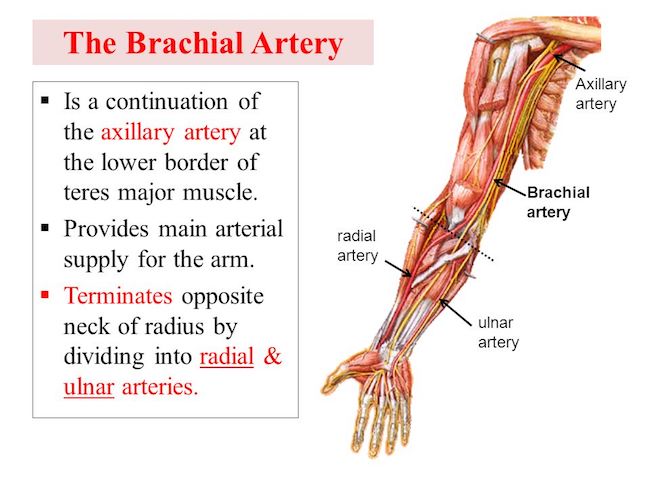
Importance: The brachial artery is THE major blood vessel of the upper limb (Anatomy Lesson #19, To Arms, Too Arms, Two Arms!), providing each with almost a liter of blood (.95 qt.) per minute! Understand, this is a huge blood flow given that the entire human body typically contains only 4.7 – 5.5 liters of blood.
Note #1: Blood flow through the subclavian artery, the parent of brachial artery, is difficult to measure because it lies so deep, but it’s blood flow would be slightly higher than the axillary artery.
Try This: This could be fun! The brachial artery carries so much blood, its pulse can be taken to determine heart rate. This is how you can find your brachial pulse. Identify your biceps with the contralateral (opposite) hand. Move middle and ring fingers along its inner border toward the inner elbow and apply moderate pressure (Image E). Feel it? Yay!
Note #2: Today, pulse is often taken using a finger clip device (pulse oximeter) but, a thorough education also includes the manual technique.
Horror: I see many examples on the Internet advising students to take a pulse with their thumb!!! These grieves me, because one should never take a pulse with the thumb. The thumb has its own substantial artery, the princeps pollicis, with its own pulse – large enough to interfere with determining a patient’s pulse! In some people, the index finger also has a strong pulse, so using the middle and ring fingers are best.
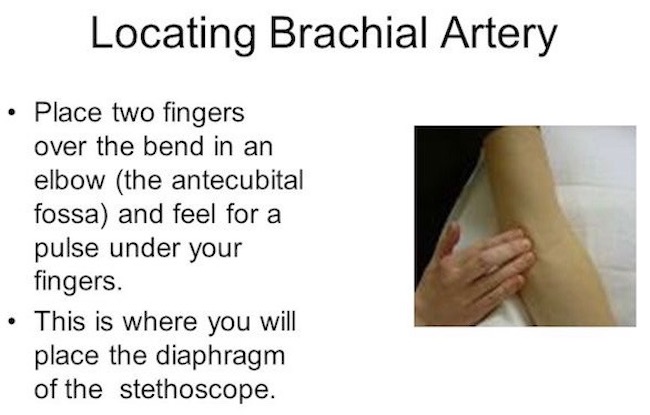
Should you be interested, here is a nice video about locating the brachial artery pulse. The demonstrator uses a slightly different approach than the one described above, but either works well:
Conclusion: Two arteries are candidates for Claire’s Concern: left axillary or left brachial. Each has a huge blood flow and if their wall is torn or cut, a person could easily exsanguinate through the breach.
But, which one? The location of her incision informs our choice. Back to an earlier image: Claire’s tools are inserted just under the outer border of Jamie’s pectoralis major muscle (mercy!) and above the armpit (oxter hair lies below). One may reasonable conclude that her tools’ trajectory towards the armpit is most consistent with the pathway of the axillary artery; the brachial artery should be further out towards the arm. Ergo, Claire is concerned that birdshot or tools may harm the axillary artery.
But, know this….it is difficult to be absolutely sure sans a proper visual evaluation of the area accompanied with palpation. I volunteer! He he.
So, we have answered our initial query: Likely, Claire was fearful of damaging Jamie’s axillary artery not his achy brachial artery, but either would suffice.

Cosmic Question: Now, comes the most critical question of all!
How can a surgeon operate on an intoxicated patient, with dim lighting, using fairly cumbersome tools, answering questions from a curious nephew, removing multiple bloody foreign objects, and yet complete her tour of duty with an absolutely pristine apron???? Not a drop of blood in sight!
Because, she is the Sassynach Surgeon in her bad-ass bat suit and Claire can fix pretty much anything!
Arteries might not be the sexiest of anatomical topics, but we can understand and appreciate their value, especially if they are damaged or dysfunctional. Let’s join Claire with a toast to our awesome arteries: Slàinte Mhath!
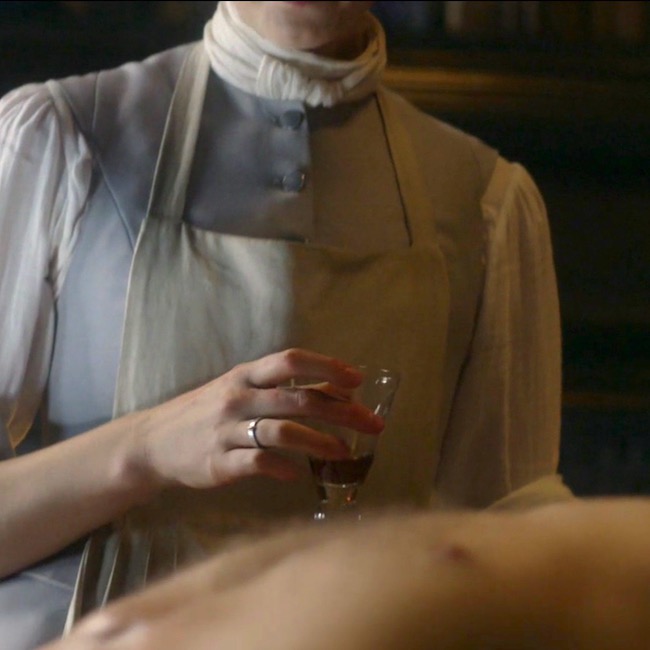
A deeply grateful,
Outlander Anatomist
Photo Creds:
Starz: Outlander episode 308, First Wife; www.biology.stackexchange.com (Image B); www.earthslab.com (Image C); www.humananatomly.com (Image A); www.slideplayer.com (Image D, E)
